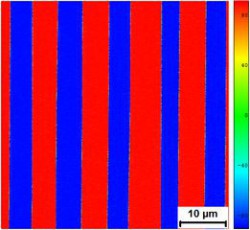|
||||
|
|
|
PFM03
PFM03 - Test Pattern for the Piezoresponse Force Microscopy Periodically poled lithium niobate
Test pattern PFM03 is intended for • setting of the Piezoresponse Force Microscopy (PFM) mode,
• optimization of the modulation voltage parameters (frequency, phase and amplitude),
• test measurements in the PFM mode.
Sample description
Lithium niobate (LiNbO3) single-crystalline 500- µm-thick plate with roughness less than 10 nm cut normal to the polar axis.
A regular domain structure with period D was created in the sample. The spontaneous polarization has the opposite direction in the neighboring domains. The polarization direction determines the sign of piezoelectric coefficient. Analysis of the local piezoelectric response during application of the modulation voltage allows to reveal the domain pattern.
Quick Start Guide
The sample is fixed on the AFM holder and its bottom electrode is grounded. The measurements are held in contact mode. AC voltage with a frequency fmod is applied to AFM tip. The sample surface oscillates with the same frequency. This response is analyzed using the lock-in amplifier. The domain walls contrast can be obtained in the amplitude of the piezoresponse signal, and domain contrast – in the phase of the signal. The typical images obtained by PFM mode are shown in Figure 1.
 (a) (a)  (b) (b)  (c) (c)Figure 1. The typical domain pattern obtained in the sample by PFM mode: (a) amplitude and (b) phase of piezoresponse signal, (c) phase profile. Diamond coated conductive tip DCP10. AC voltage amplitude 7,5 V, fmod = 17 kHz. |
Copyright © 1998 - 2025, NT-MDT SI


